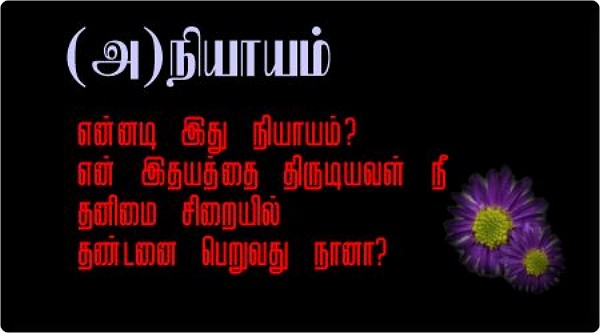love poems in tamil
Classical Tamil love poetry assigns the human experiences it describes, and in particular the subjective topics that those experiences relate to, to specific habitats. Every situation in the poems is described using themes in which the time, the place and the floral symbols of each episode are codified. These codifications are used as symbols to imply a socio-economic order, occupations and behaviour patterns, which, in turn, are symbolized, by specific flora and fauna. Details of secondary aspects are just as rigidly codified - the seasons, the hour a god, musical instruments and, above all, the sentimental connotations of each landscape: lovers' meetings, patient waiting, lovers' quarrels, separation, and the anxiously awaited return.
Under this codification, the inner universe associated with love is divided into seven modes, or thinai, five of which are geographical and associated with specific landscapes, and two of which are non-geographical and not associated with any specific landscape. Four of the geographical landscapes are described as being landscapes that occur naturally in the Tamil lands. These are: kuṟiñci (குறிஞ்சி) - mountainous regions, associated with union, mullai (முல்லை) - forests, associated with waiting, marutam (மருதம்) - cropland, associated with quarreling, and neytal (நெய்தல்) - seashore, associated with pining. The fifth - pālai (பாலை), or desert, associated with separation - is described in the Tolkappiyam as not being a naturally existing landscape.
Under this codification, the inner universe associated with love is divided into seven modes, or thinai, five of which are geographical and associated with specific landscapes, and two of which are non-geographical and not associated with any specific landscape. Four of the geographical landscapes are described as being landscapes that occur naturally in the Tamil lands. These are: kuṟiñci (குறிஞ்சி) - mountainous regions, associated with union, mullai (முல்லை) - forests, associated with waiting, marutam (மருதம்) - cropland, associated with quarreling, and neytal (நெய்தல்) - seashore, associated with pining. The fifth - pālai (பாலை), or desert, associated with separation - is described in the Tolkappiyam as not being a naturally existing landscape.

















1 Comments:
Considering today’s education tendency, we think writing is significant academic component, so you can’t ignore its meaning. Writing demonstrates the educational level of every student. We have a great web developers team so that you feel comfortable navigating our site, have a glimpse at this web-site to find more!
Post a Comment
Subscribe to Post Comments [Atom]
<< Home